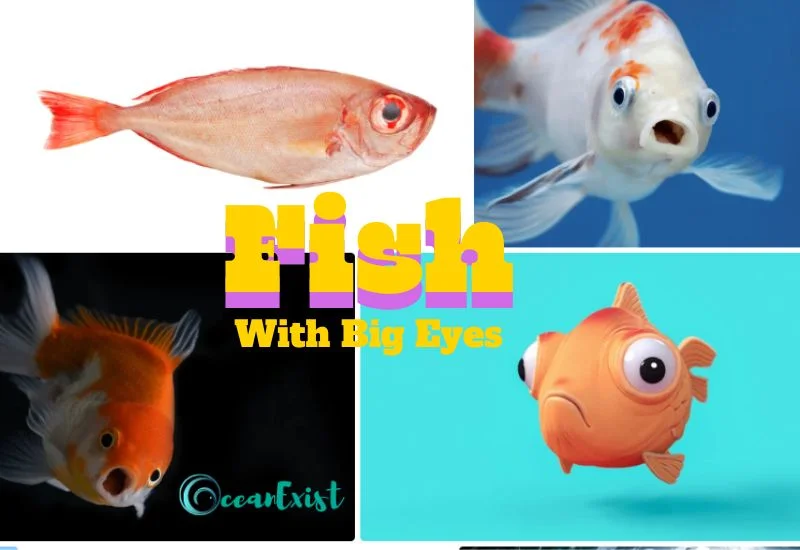Nature never fails to mesmerize us. Around 35,000 fish species have been discovered, and scientists claim roughly 10,000 fish are yet to be explored. Many of the fish are odd in shape, and others are odd in nature.
However, among these creatures, the bigeye fish stand out. These fish, with their huge eyes, are surprising in their characteristics and impressive to behold. There are not just a few fish with big eyes; there are hundreds. You can even pet some of the big-eyed fish in your aquariums.
To your surprise, we have explored beneath the ocean depths and come up with the top twenty fish with big eyes. Let’s explore these fish pictures to know how they live, what they eat, and whether they are suitable to pet.
So, let’s embark on our journey.
The facts about what you are going to know about fish with big eyes are written below.
- Family:
- Scientific name:
- Diet:
- Origin:
- Size:
- Lifespan:
- Water type:
- Aquarium friendly?
Here we go!
Celestial Goldfish
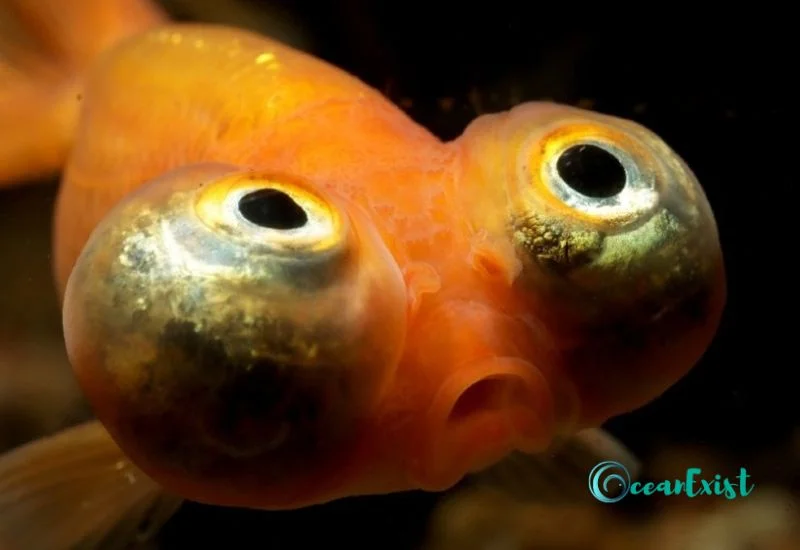
Having massive eyes, the celestial goldfish is the first and the most important fish with big eyes. They are goldfish and are also called Choutengan.
They have big eyes, pointing upward. That is why they are called celestial fish that always look at the stars.
They have eyes on their head in an upward direction. These fish’s eyes are bigger than their whole mouth. It is said that they do not have good vision in the areas where they move.
- Family: Cyprinidae
- Scientific Name: Carassius auratus
- Diet: plants and small animals
- Origin: China
- Size: 6 inches (15 cm)
- Lifespan: 10-15 years
- Water Type: Freshwater
- Aquarium Friendly? Yes
Norman’s Lampeye Killifish
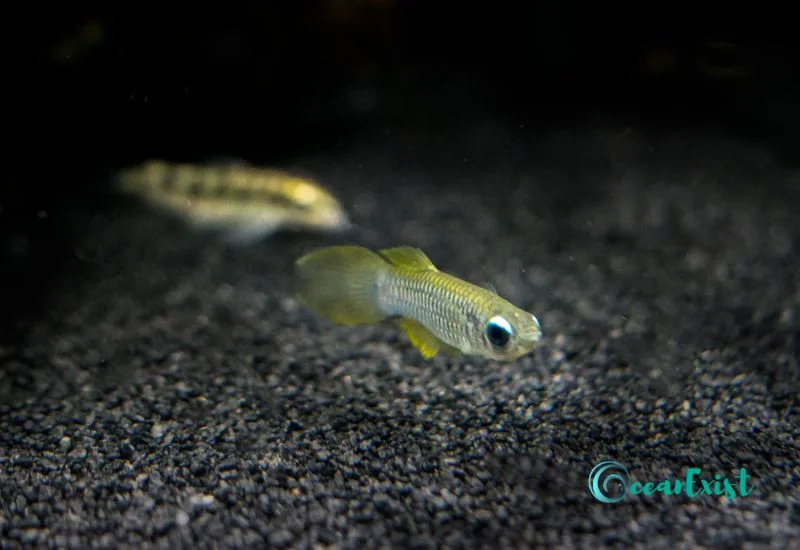
Norman’s Lampeye Killifish are small fish with white bodies. But compared to their body, they have large eyes on the sides.
Their vision is more clear at the sides rather than they are moving in the direction. They grow up to 1.5 inches, and you can put them in your aquarium.
- Family: Aplocheilidae
- Scientific Name: Aplocheilichthys normani
- Diet: prefers live or frozen foods
- Origin: West Africa (Nigeria, Cameroon)
- Size: 1.5 inches (3.8 cm)
- Lifespan: 2-3 years
- Water Type: Freshwater
- Aquarium Friendly? Yes
Amazon Pufferfish
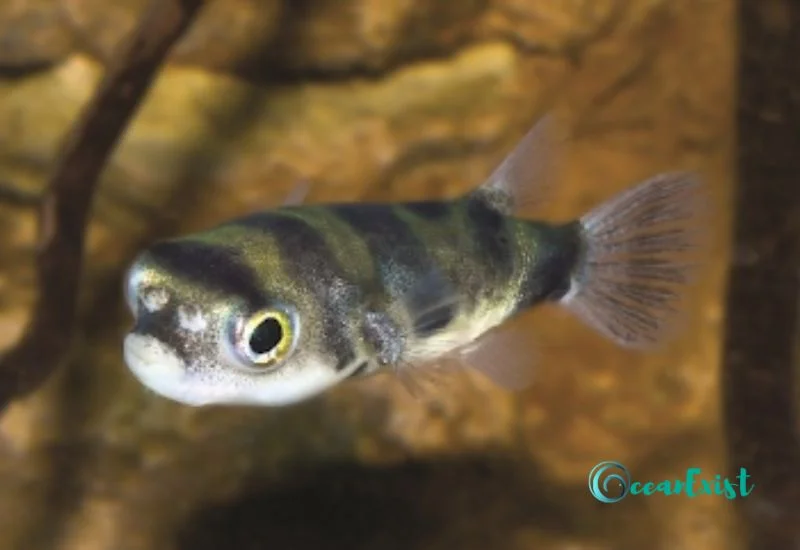
Amazon pufferfish belong to the pufferfish family. They have two big eyes on the sides. Their eyes size is comparatively larger than their body.
These fish grow up to 4 inches. Found in Mexico, these fish have wild-like colors with gray and darker strips all over the body.
- Family: Tetraodontidae
- Scientific Name: Colomesus asellus
- Diet: small invertebrates and snails
- Origin: South America (Amazon River basin)
- Size: 4 inches (10 cm)
- Lifespan: 5-7 years
- Water Type: Freshwater
- Aquarium Friendly? Same species tanks
Telescope Goldfish
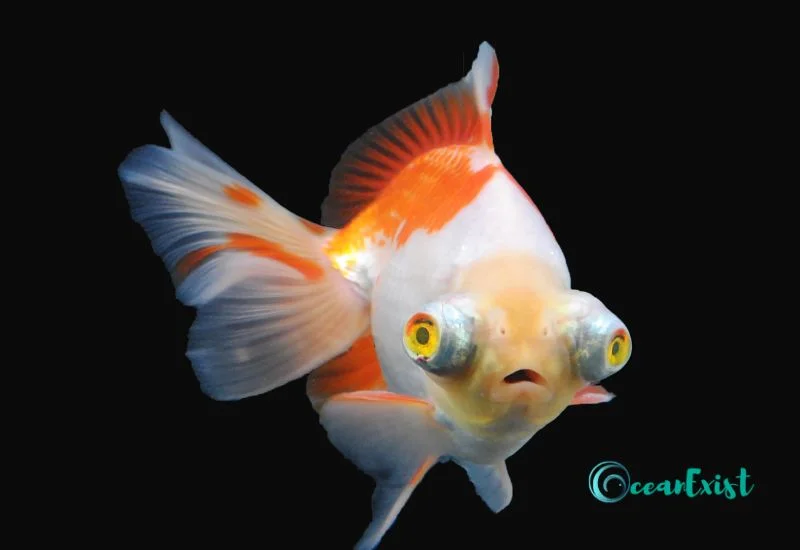
Like celestial goldfish, telescope goldfish is another type of goldfish characterized by protruding big eyes. These fish were developed in China in 1700 and are commonly available for home aquariums.
With protruding eyes, they see 80% to their sides, and their vision where they move is less. Having so many varieties and colorations, you can put them in your aquarium to enhance your tank’s beauty.
- Family: Cyprinidae
- Scientific Name: Carassius auratus
- Diet: eats plants, insects, and small crustaceans
- Origin: China
- Size: 6-8 inches (15-20 cm)
- Lifespan: 10-15 years
- Water Type: Freshwater
- Aquarium Friendly? Yes
Bolivian Ram Cichlid
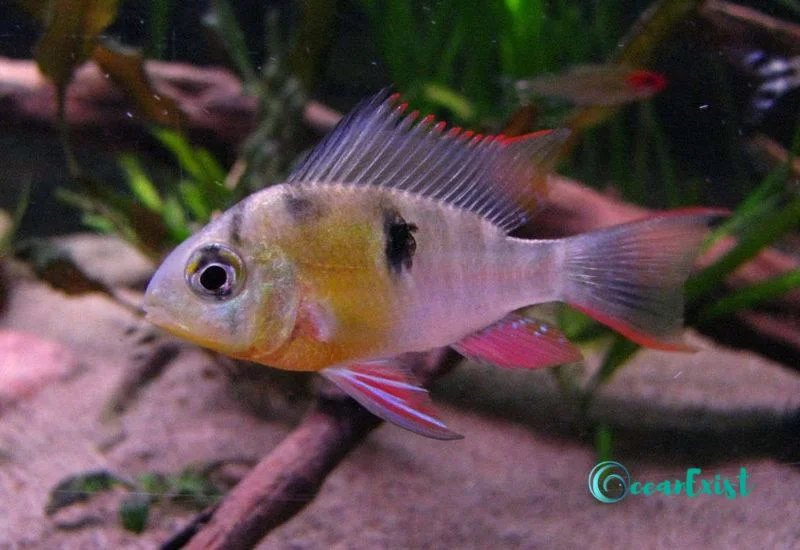
Bolivian ram cichlids belong to the cichlidae family. They have bigger eyes on their sides. They grow up to 3 to 4 inches.
Found in the Bolivian region, they are freshwater fish with big eyes and can live up to 5 years. These fish are also aquarium-friendly.
- Family: Cichlidae
- Scientific Name: Mikrogeophagus altispinosus
- Diet: small insects, worms, and plant matter
- Origin: South America (Bolivia)
- Size: 3-4 inches (7.6-10 cm)
- Lifespan: 4-5 years
- Water Type: Freshwater
- Aquarium Friendly? Yes
Glassfish
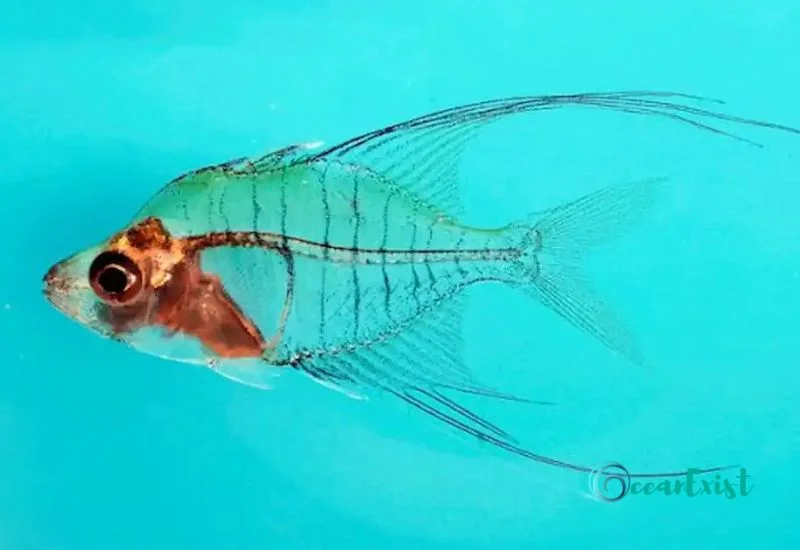
Glassfish have larger eyes compared to normal size. As the name suggests, their body is like glass and looks transparent.
These with big eyes are found in South Asia, where they live in freshwater. They grow up to 4 inches and eat live and frozen food. Being hardy, they are suitable for aquarium fish.
- Family: Ambassidae
- Scientific Name: Parambassis ranga
- Diet: live or frozen foods
- Origin: Southeast Asia (India, Bangladesh)
- Size: 4 inches (10 cm)
- Lifespan: 3-5 years
- Water Type: Freshwater
- Aquarium Friendly? Yes
Bubble Eye Goldfish
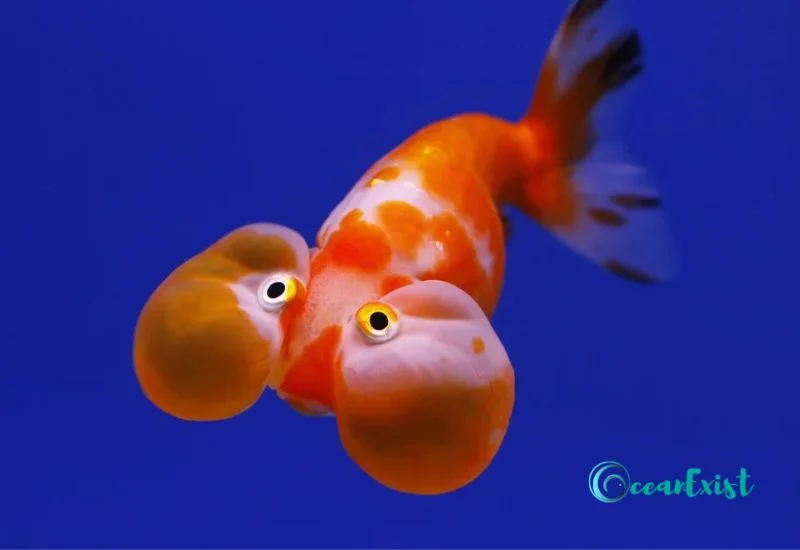
The most unique and the most interesting fish with the biggest eyes compared to the size are bubble fish goldfish. Belonging to the goldfish community, these fish grow up to 6 inches.
These are also found in China, where their diet is omnivores. Even being so interesting, you put them in home aquariums.
- Family: Cyprinidae
- Scientific Name: Carassius auratus
- Diet: Omnivorous
- Origin: China
- Size: 4-6 inches (10-15 cm)
- Lifespan: 10-15 years
- Water Type: Freshwater
- Aquarium Friendly? Yes
Mandarin Dragonet
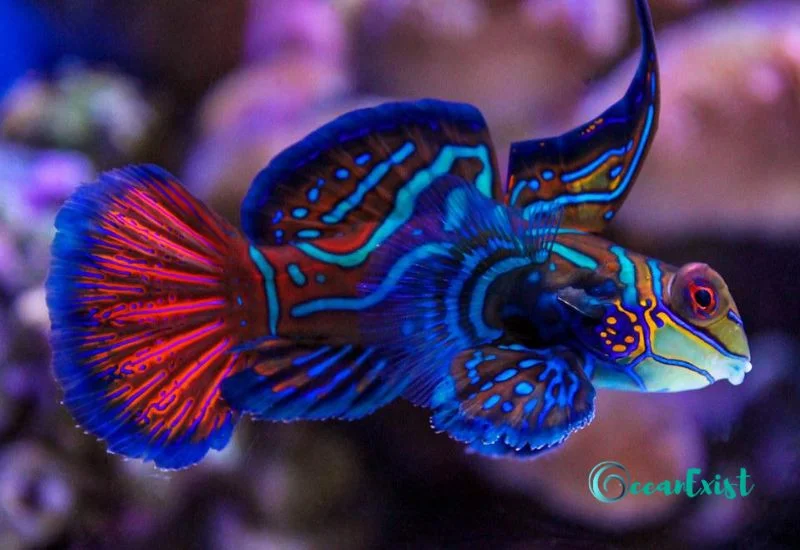
If you ask about fish with striking colors and beautiful patterns with big eyes, the Mandarin Dragonet is at the top. They get their name from the Chinese bureaucrats who used to wear colorful uniforms.
They have two big eyes on the top of their head, pointing toward the sides. These grow up to 4 inches and live for five years.
Being hardy and so much trekking, you can put them in the home aquarium, where they feed them with small crustaceans and copepods.
- Family: Callionymidae
- Scientific Name: Synchiropus splendidus
- Diet: eats small crustaceans and copepods
- Origin: Pacific Ocean (Southwest Pacific)
- Size: 4 inches (10 cm)
- Lifespan: 3-5 years
- Water Type: Marine
- Aquarium Friendly? Yes
Parrotfish Cichlid
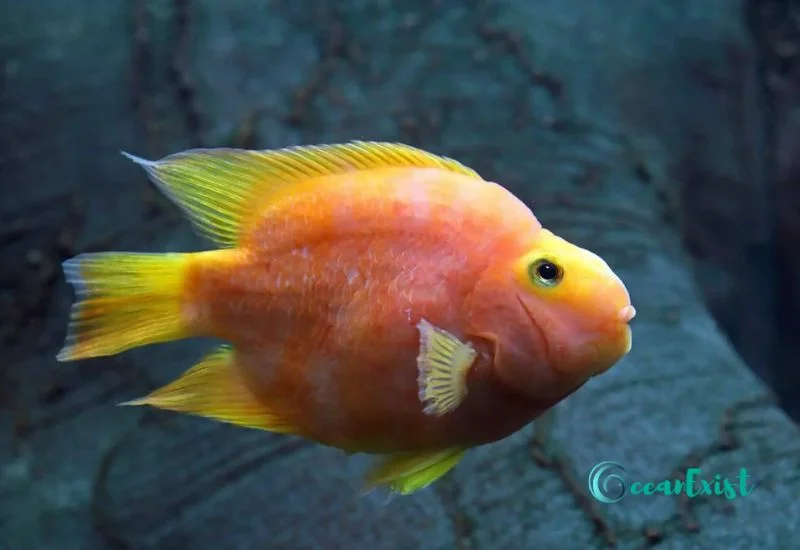
Parrotfish cichild is another type of cichlid having two big eyes on the sides. This is because they are a hybrid breed of the Cichldae family.
They grow up to 10 inches. You can find them in the Amazon River basin in orange. They are omnivores and eat plants and fish.
Being hardy and requiring low care, these are also suitable for home aquariums.
- Family: Cichlidae
- Scientific Name: Hoplarchus Psittacus
- Diet: eats plant matter, insects, and small fish
- Origin: South America (Amazon River basin)
- Size: 10 inches (25 cm)
- Lifespan: 10-15 years
- Water Type: Freshwater
- Aquarium Friendly? Yes
African Butterfly Fish
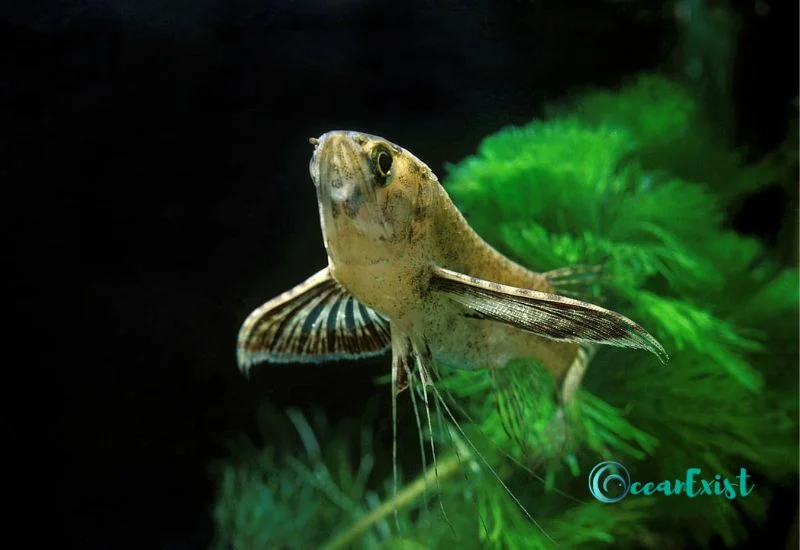
As the name indicates, African butterfly fish resemble butterflies. They have big eyes at the top of their head. These are found in freshwater, where they thrive in planted regions.
These fish eat insects and small fish and grow up to 10 inches. Their lifespan is about 5 to 8 years. You can put them in a water tank in your home.
- African Butterfly Fish
- Family: Pantodontidae
- Scientific Name: Pantodon buchholzi
- Diet: insects and small fish
- Origin: West and Central Africa (Nigeria, Cameroon)
- Size: 5 inches (13 cm)
- Lifespan: 5-8 years
- Water Type: Freshwater
- Aquarium Friendly? Yes
Big Eye Black Bar Soldierfish
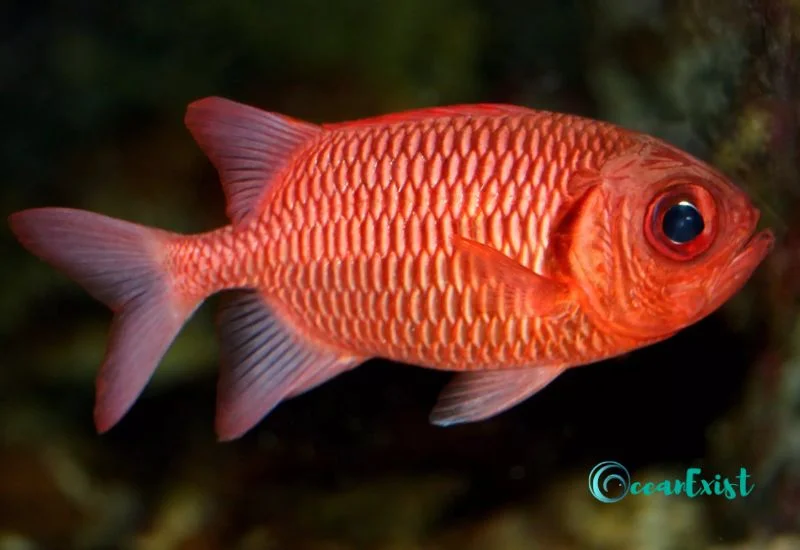
Commonly known as Myripristis jacobus, Big Eye Black Bar Soldierfish is a nocturnal fish with big eyes on top of the head.
Foun in the marine Indo-Pacific regions, these fish eat small fish and crustaceans. These grow up to 6 inches in length and are aquarium-friendly.
- Family: Holocentridae
- Scientific Name: Myripristis jacobus
- Diet: small fish and crustaceans
- Origin: Tropical Indo-Pacific regions
- Size: 6 inches (25 cm)
- Lifespan: 5-8 years
- Water Type: Marine
- Aquarium Friendly? Yes
Squirrelfish
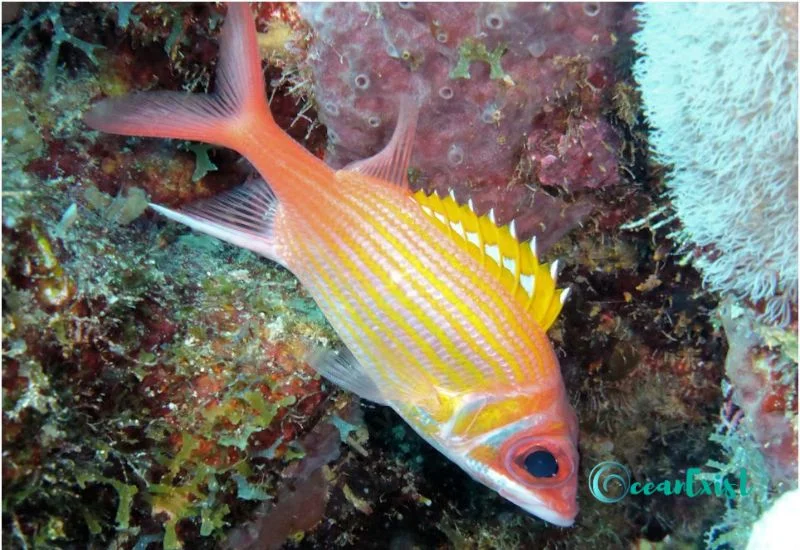
You can call them scary or interesting, but squirrelfish are distinct species. Squirrelfish have very big eyes and sharp dorsal fins.
Their big eyes are on the top of their heads. These fish are wider at the mouth due to their large eyes. These orange-colored fish are found in tropical regions of the Atlantic oceans and can grow up to 12 inches.
Interestingly, they are hardy, and you can eat them in your home aquarium.
- Family: Holocentridae
- Scientific Name: Holocentrus adscensionis
- Diet: small fish and crustaceans
- Origin: Tropical Atlantic Ocean
- Size: 12 inches (30 cm)
- Lifespan: 5-10 years
- Water Type: Marine
- Aquarium Friendly? Yes
Swordfish
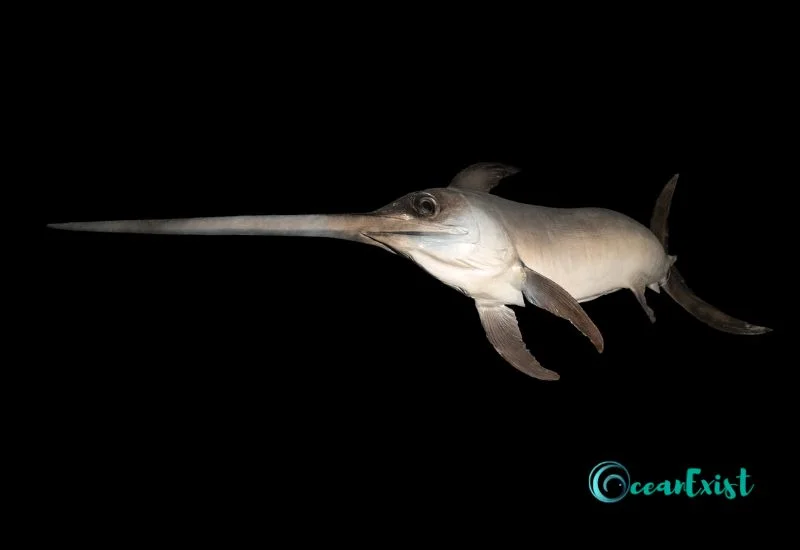
Swordfish are among the fish that have big eyes. Juvenile swordfish eyes look bigger than the mature fish.
As the name indicates, their mouth is sharp like a sword, and they are big fish growing up to 15 feet and can live up to 10 years.
But being aggressive and large, you can keep them in aquariums.
- Family: Xiphiidae
- Scientific Name: Xiphias gladius
- Diet: ish and squid
- Origin: Worldwide in tropical and temperate seas
- Size: 15 feet (4.6 meters)
- Lifespan: 10 years
- Water Type: Marine
- Aquarium Friendly? No
Bigeye Tuna
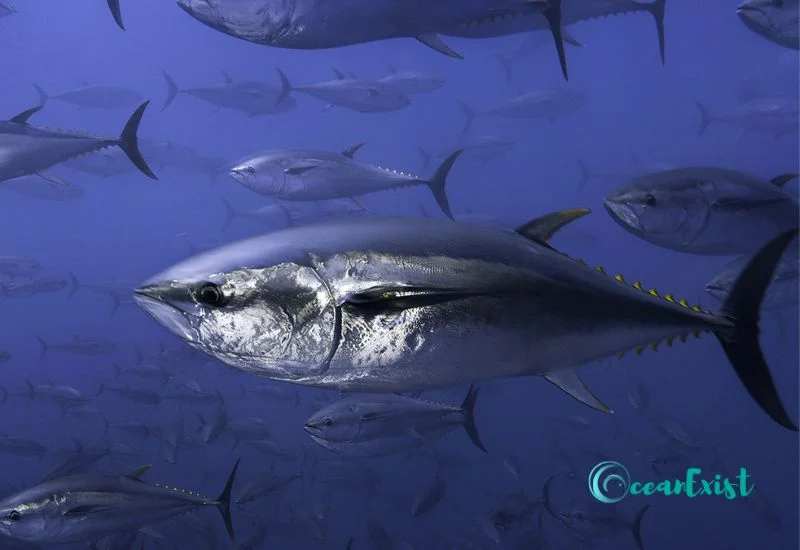
Bigeye tuna is another type of fish with big eyes. Their body is round, with two big eyes on top of the head. These tunas grow up to 8 feet and fish, squid, and other small insects.
These are found worldwide in tropical waters and can live up to 12 years. Like I said before, you can not pet them.
- Family: Scombridae
- Scientific Name: Thunnus obesus
- Diet: fish, squid, and crustaceans
- Origin: Worldwide in tropical and temperate oceans
- Size: 7.5 feet (2.3 meters)
- Lifespan: 12 years
- Water Type: Marine
- Aquarium Friendly? No
Horse-Eye Jack
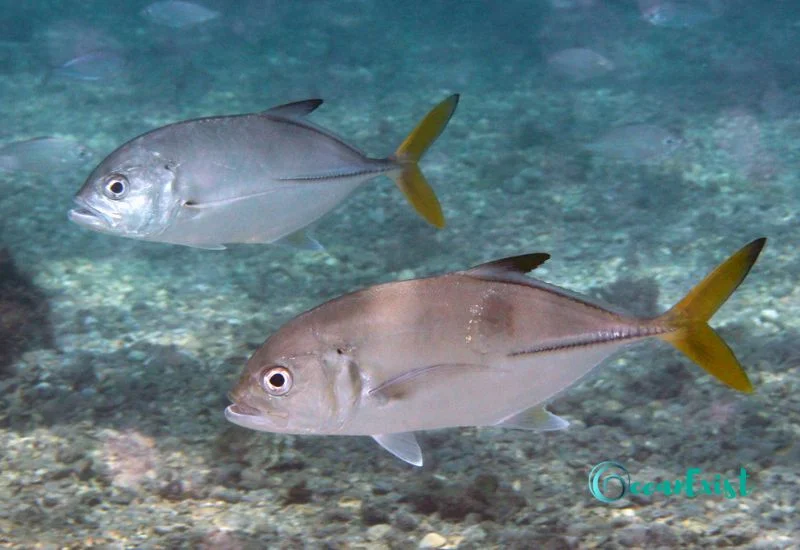
Horse eye jack have two big eyes on the top of the head pointing toward the sides. These greyish fish have large and round bodies that grow up to 3 feet.
These are carnivores and eat small fish and crustaceans. These are found in marine waters. They are not suitable or aquarium-friendly fish.
- Family: Carangidae
- Scientific Name: Caranx latus
- Diet: small fish and crustaceans
- Origin: Western Atlantic Ocean
- Size: 3 feet (90 cm)
- Lifespan: 10-15 years
- Water Type: Marine
- Aquarium Friendly? Not suitable
Tarpon
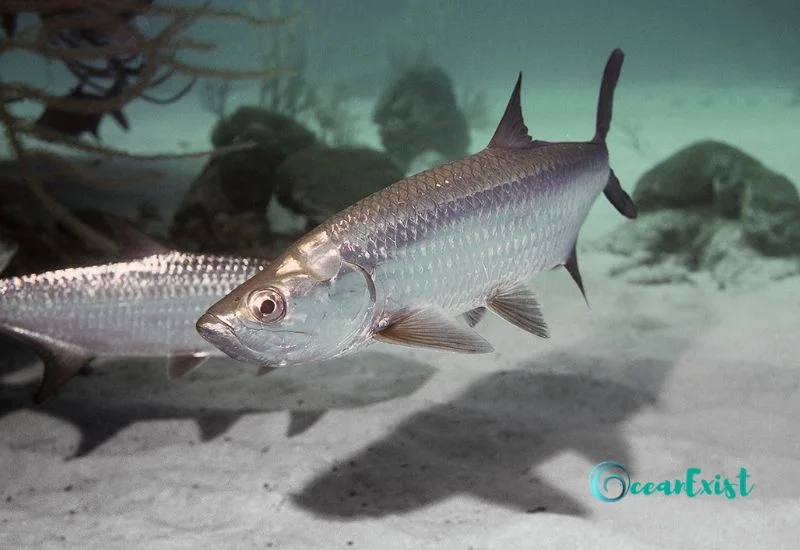
Trapons are massive fish with big eyes. These big eyes help them prey and thrive in dim environments.
They grow up to 8 feet and eat small fish and crustaceans. They are not suitable for home aquariums.
- Family: Megalopidae
- Scientific Name: Megalops atlanticus
- Diet: Carnivorous
- Origin: Coastal and estuarine waters of the Atlantic Ocean
- Size: 8 feet (2.4 meters)
- Lifespan: 30-50 years
- Water Type: Marine and freshwater
- Aquarium Friendly? Not suitable
Ocean Sunfish

The massive ocean sunfish have large eyes on the sides. They are big and grow more than 10 feet. They are round and live in marine. These are round and weigh more than thousands of lbs.
Ocean sunfish benefit from these two big eyes where they prey and live in dim environments. Being so gigantic, you can not keep them in home tanks.
- Family: Molidae
- Scientific Name: Mola mola
- Diet: jellyfish and zooplankton
- Origin: Temperate and tropical oceans worldwide
- Size: 10 feet (3 meters)
- Lifespan: 10 years
- Water Type: Marine
- Aquarium Friendly? Not suitable
Rockfish
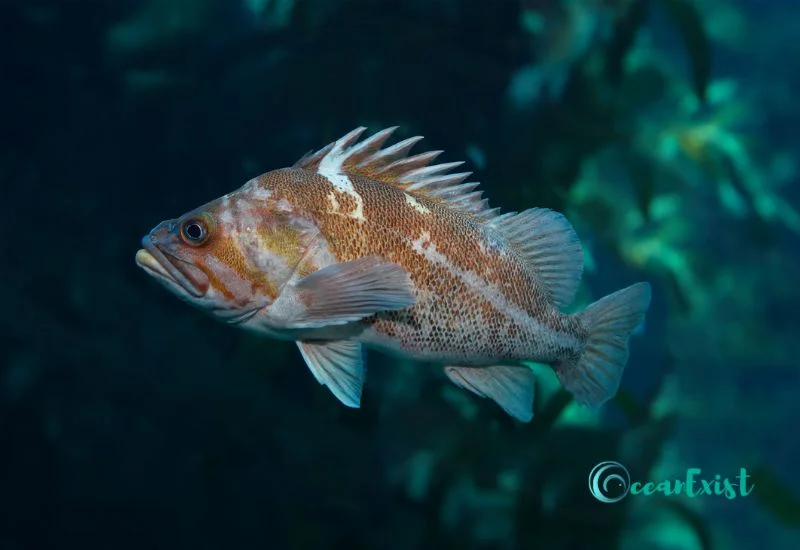
Rockfish are creepy-looking fish with big eyes on the top of the head, sharp and neel-like dorsal fins, and big mouths.
They have big eyes because they live in the depths of the ocean, where these big eyes help them prey and navigate through the sea.
Rockfish grow up to two feet and eat small fish and crustaceans. The life span is between 10 to 50 years. Even being so creepy, you can keep them in large aquariums where no small fish live.
- Family: Sebastian
- Scientific Name: Sebastes spp.
- Diet: smaller fish and crustaceans
- Origin: Coastal waters of the Pacific Ocean
- Size: 6-24 inches (15-60 cm)
- Lifespan: 10-50 years
- Water Type: Marine
- Aquarium Friendly? Large aquariums.
Bigeye Fish
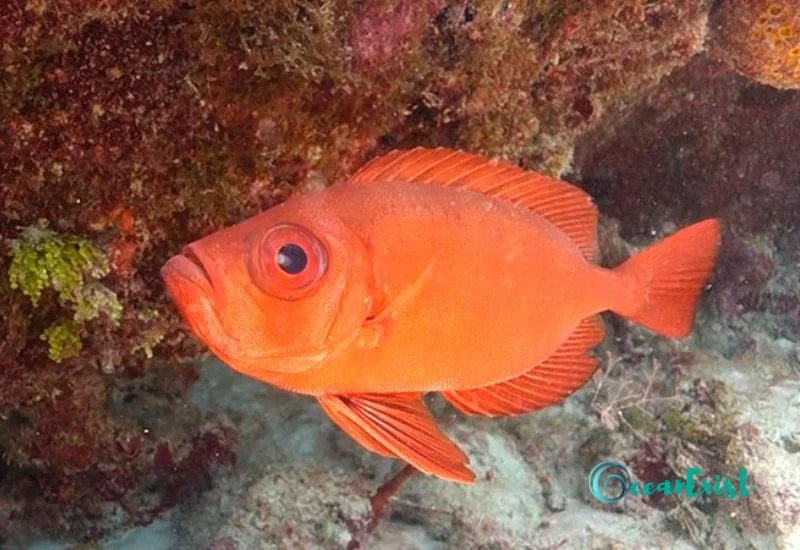
Bigeye fish is the most common and known fish with big eyes. They have orange bodies with two gigantic eyes on the top.
These big eyes help them prey and navigate in the depths. Moreover, they also grow up to two feet and live up to 10 years.
They are found in marine waters worldwide. You can also keep them in your marine aquarium and fit them with smaller fish and invertebrates.
- Family: Priacanthidae
- Scientific Name: Priacanthus spp.
- Diet: smaller fish and invertebrates
- Origin: Tropical and subtropical oceans worldwide
- Size: 12-24 inches (30-60 cm)
- Lifespan: 10 years
- Water Type: Marine
- Aquarium Friendly? Large marine aquariums.
Barracuda
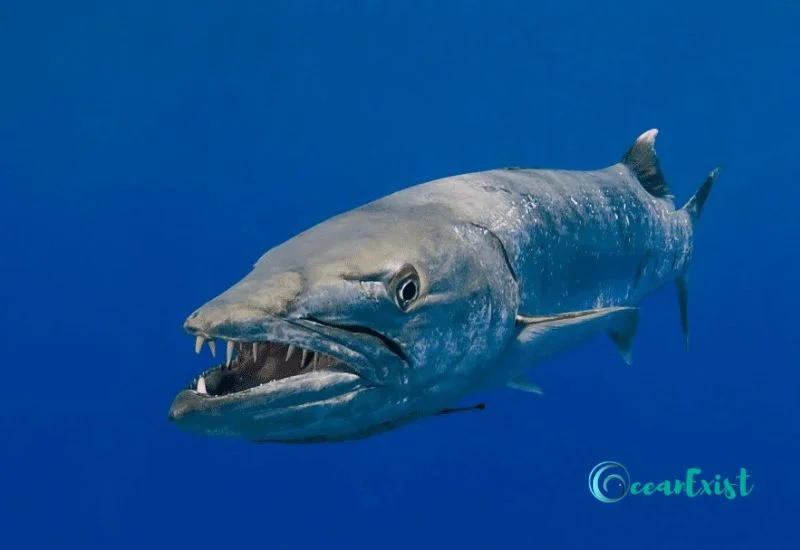
Barracuda are large, pointy, and carnivorous fish with big eyes. Their large fish help them prey, identify prey, and navigate through depths in dim lights.
They are found in tropical and subtropical oceans worldwide. These live in marine waters and grow up to 6 feet. No aquarist has ever put them in their water tanks due to their large and aggressive nature.
- Family: Sphyraenidae
- Scientific Name: Sphyraena spp.
- Diet: Carnivorous; feeds on other fish
- Origin: Tropical and subtropical oceans worldwide
- Size: 18 inches to 6 feet (60–100 cm)
- Lifespan: 10-15 years
- Water Type: Marine
- Aquarium Friendly? Not suitable
Now you know about different types of fish with big eyes, but what causes them to have big eyes?
Let us get an answer to this question.
Why Do Some Species Have Big Eyes?
The short answer is it is natural. However, there is a whole science behind fish having big eyes. Big eyes serve several essential purposes in different fish species.
Big eyes are due to several factors. Big eyes enhance vision in various environments and give an advantage during a hunt. Moreover, big eyes can be caused by selective breeding health conditions.
Let’s explore four key reasons why certain fish possess oversized eyes.
Night Vision
Many of these big-eyed fish live in dim environments, akin to nocturnal animals like owls. Due to natural conditions and all-time focus, their eyes become large to match with the environment. These big eyes then improve visibility.
Nocturnal species such as squirrelfish and deep-sea dwellers like Genie’s dogfish utilize their big eyes to gather and focus light.
These big eyes with strong night vision help in predator detection and prey pursuit under low-light conditions.
Hunting Advantage
It is a natural process in which living beings acquire what they seek. Fish with big eyes are those needed to prey in timid lights. Due to this behavior, their eyes grew bigger.
Even diurnal fish like barracuda benefit from their large eyes. Swift and predatory fish require acute eyesight to track and efficiently capture prey during daylight hours. Bigeyes enhance fish hunting success.
Selective Breeding
Some fish with big eye sizes are products of selective breeding. Similar to how humans have cultivated dog breeds, certain fish varieties like telescope goldfish have huge eyes due to selective breeding efforts.
Health Conditions
Occasionally, pet fish develop a condition known as exophthalmia, colloquially termed “popeye” by aquarists.
This condition, stemming from trauma, infection, or poor water quality, results in protruding eyes and requires prompt attention.
Popeye Fish Care
Popeye is a serious ailment that leads to permanent eye damage if untreated. Popeye’s illness mainly happens due to low water quality.
Popeye treatment options are Epsom salts to reduce swelling or antibiotics to combat infections that can aid in the fish’s recovery.
Conclusion
The top twenty types of fish with big eyes are covered here. These fish are worth seeing, and the big eyes make them interesting to some and scary to others.
However, their eyes are affected by several factors: to enhance night vision by selective breeding, hunting advantage, and health conditions.
It was all from my side.
If you have anything to add or suggest, please leave a comment down below.
If you have enjoyed this blog, let us learn more about the interesting creatures. This time, we picked fish with legs.
Should we move ahead?
